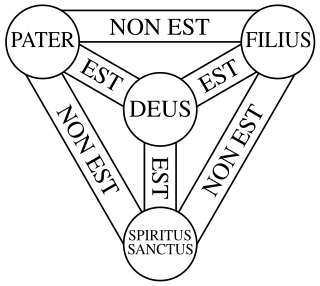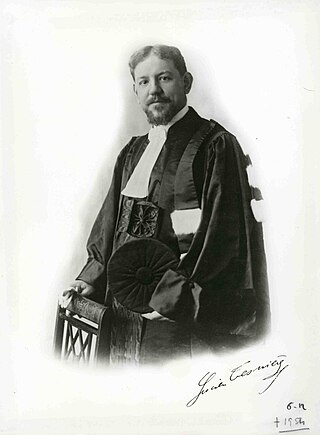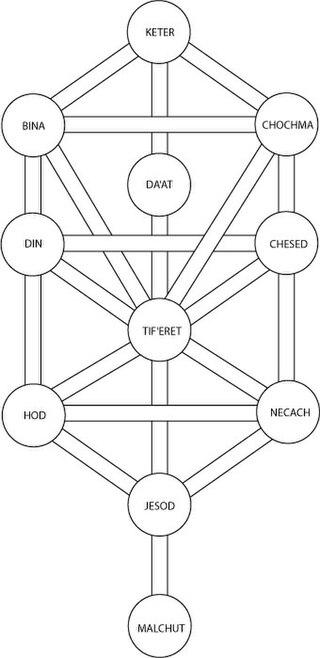
In biological phylogenetics, a clade, also known as a monophyletic group or natural group, is a grouping of organisms that are monophyletic – that is, composed of a common ancestor and all its lineal descendants – on a phylogenetic tree. In the taxonomical literature, sometimes the Latin form cladus is used rather than the English form.

The state and war flag of San Marino is formed by two equal horizontal bands of white (top) and light blue with the national coat of arms superimposed in the center; the coat of arms has a shield with a closed crown on top, flanked by an oak and laurel wreath, with a scroll below bearing the word LIBERTAS (Liberty). The two colors of the flag represent peace (white) and liberty.

A parse tree or parsing tree or derivation tree or concrete syntax tree is an ordered, rooted tree that represents the syntactic structure of a string according to some context-free grammar. The term parse tree itself is used primarily in computational linguistics; in theoretical syntax, the term syntax tree is more common.

Textual criticism is a branch of textual scholarship, philology, and literary criticism that is concerned with the identification of textual variants, or different versions, of either manuscripts (mss) or of printed books. Such texts may range in dates from the earliest writing in cuneiform, impressed on clay, for example, to multiple unpublished versions of a 21st-century author's work. Historically, scribes who were paid to copy documents may have been literate, but many were simply copyists, mimicking the shapes of letters without necessarily understanding what they meant. This means that unintentional alterations were common when copying manuscripts by hand. Intentional alterations may have been made as well, for example, the censoring of printed work for political, religious or cultural reasons.

Graphviz is a package of open-source tools initiated by AT&T Labs Research for drawing graphs specified in DOT language scripts having the file name extension "gv". It also provides libraries for software applications to use the tools. Graphviz is free software licensed under the Eclipse Public License.
Tree diagram may refer to:

A simple eye refers to a form of eye or an optical arrangement composed of a single lens and without an elaborate retina such as occurs in most vertebrates. In this sense "simple eye" is distinct from a multi-lensed "compound eye", and is not necessarily at all simple in the usual sense of the word.

The Shield of the Trinity or Scutum Fidei is a traditional Christian visual symbol which expresses many aspects of the doctrine of the Trinity, summarizing the first part of the Athanasian Creed in a compact diagram. In late medieval Europe, this emblem was considered to be the heraldic arms of God.

Lucien Tesnière was a prominent and influential French linguist. He was born in Mont-Saint-Aignan on May 13, 1893. As a senior lecturer at the University of Strasbourg (1924) and later professor at the University of Montpellier (1937), he published many papers and books on Slavic languages. However, his importance in the history of linguistics is based mainly on his development of an approach to the syntax of natural languages that would become known as dependency grammar. He presented his theory in his book Éléments de syntaxe structurale, published posthumously in 1959. In the book he proposes a sophisticated formalization of syntactic structures, supported by many examples from a diversity of languages. Tesnière died in Montpellier on December 6, 1954.

The emblem of the Italian Republic was formally adopted by the newly formed Italian Republic on 5 May 1948. Although often referred to as a coat of arms, it is an emblem as it was designed not to conform to traditional heraldic rules. The emblem is used extensively by the Italian government.

The Tree of Life is a diagram used in Kabbalah and various other mystical traditions. It usually consists of 10 or 11 nodes symbolizing different archetypes and 22 lines connecting the nodes. The nodes are often arranged into three columns to represent that they belong to a common category.

A tree of virtues is a diagram used in medieval Christian tradition to display the relationships between virtues, usually juxtaposed with a tree of vices where the vices are treated in a parallel fashion. Together with genealogical trees, these diagrams qualify as among the earliest explicit tree-diagrams in history, emerging in the High Middle Ages.
The tree of life or universal tree of life is a metaphor, model and research tool used to explore the evolution of life and describe the relationships between organisms, both living and extinct, as described in a famous passage in Charles Darwin's On the Origin of Species (1859).
The affinities of all the beings of the same class have sometimes been represented by a great tree. I believe this simile largely speaks the truth.
A tree is a perennial woody plant.

The coats of arms of the Holy See and Vatican City in the form that combines two crossed keys and a tiara used as a coat of arms of the Holy See have origins attested from the 14th century. The combination of one gold and one silver key is a somewhat later development.

Debono is a surname of Italian origin, rooted from the Latin word "Bonus" meaning "Good". It originated in Northern Italy and its first known documentation appears in Parma in the thirteenth century, where it is recorded in deeds of property sale.

In mathematics, a tangle is generally one of two related concepts:

On 18 March 2013, Pope Francis adopted in his papal coat of arms the coat of arms and the motto that he used since his episcopal consecration in 1991, differenced following his election as Supreme Pontiff.

The flag of Umbria is one of the official symbols of the region of Umbria, Italy. The current flag was officially adopted on 18 March 2004, although the emblem and gonfalon had been in use since the 1970s. The Regional Law of 18 May 2004 officially confirmed the flag and added the words Regione Umbria in red, centered in the bottom fifth of the flag, but in common usage, the words are omitted.

The coat of arms of the city of Naples consists of a Samnite shield divided horizontally in half with the upper part in gold and the lower half in red. The shield is stamped with a turreted city crown of the type in use before the Royal decree n. 652 of June 7, 1943.
















